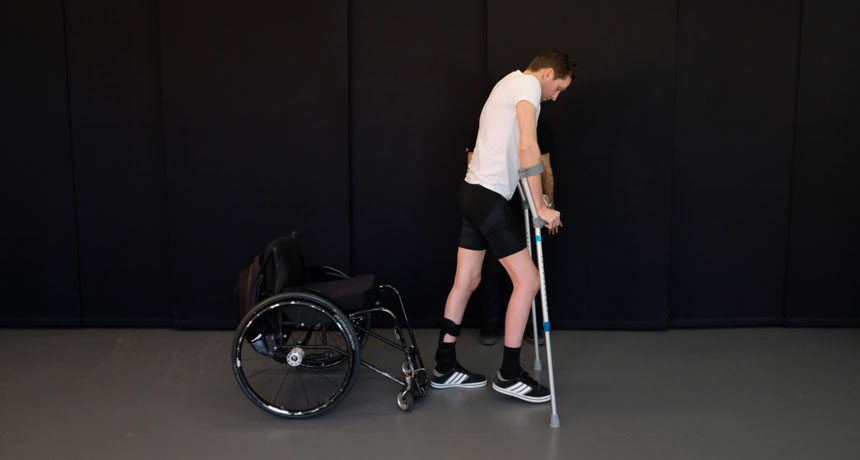Zapping the spinal cord helped paralyzed people learn to move again
Combination of electricity and intense rehab helped patients who had been immobile for years

MOVING FORWARD Gert-Jan Oskam was paralyzed in a traffic accident seven years ago. Today, he walks with crutches and targeted pulses of electricity delivered to his spinal cord.
@JEAN-BAPTISTE MIGNARDOT/EPFL
The spinal cord can make a comeback.
Intensive rehabilitation paired with electric stimulation of the spinal cord allowed six paralyzed people to walk or take steps years after their injuries, three small studies published this year showed.
“There’s a capacity here of human spinal circuitry to be able to regain significant motor control and function,” says Susan Harkema, a neuroengineer at the University of Louisville in Kentucky who led one of the studies, published in September in the New England Journal of Medicine. “That’s really exciting and really important.”
Nearly 1.5 million people in the United States have some degree of paralysis from a spinal cord injury. For many of these people, rehabilitation focuses on learning to live with their newly limited mobility.
In all three studies, patients were implanted with a small device that zaps the spinal cord. Over months of training sessions, the stimulators sent electrical signals to the patients’ spinal cord. At the same time, researchers guided the participants through physical therapy routines.
Eventually, some patients could take a few steps with no support, though most needed crutches, walkers or aid from harnesses that held them up.
Harkema’s study, and one by another team published in September in Nature Medicine, included people whose neural connections to the lower extremities didn’t work at all (SN: 10/27/18, p. 15). The third study, published in October in Nature, showed similar improvements in people who were paralyzed but had some working connections (SN: 11/24/18, p. 6).
Because people with quadriplegia consistently rate regaining use of their hands as more important than being able to walk, neuroengineer Chet Moritz is trying to restore hand movement. His group at the University of Washington in Seattle is stimulating the spinal cord through the skin (rather than via an implanted stimulator). The researchers reported improvements in finger dexterity and grip strength in one patient in the June IEEE Transactions on Neural Systems and Rehabilitation Engineering.
So far, the gains have been limited to a very small number of people who spent months going to rehab sessions several times a week. Still, this year’s advances show that, in some cases, stimulation works. Now, scientists need to figure out why. “One possible explanation … is that the stimulator acts like a hearing aid or an amplifier for the spinal cord below the injury,” Moritz says. “It could make the cord listen better to the signals coming from the brain.”
The electric pulses may also be helping to rebuild weakened neural connections — some patients were ultimately able to move voluntarily without stimulation.
That might mean that patients who begin treatment soon after an injury, before muscles and nerves have a chance to atrophy, could see even bigger improvements, says Grégoire Courtine, a neuroengineer at the Swiss Federal Institute of Technology in Lausanne and lead author of the October study in Nature.
But scientists have a lot more work to do, Harkema says. “Who can recover? How much? How far? What type of stimulation is best? All of those questions are unanswered.”







